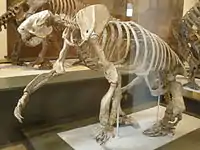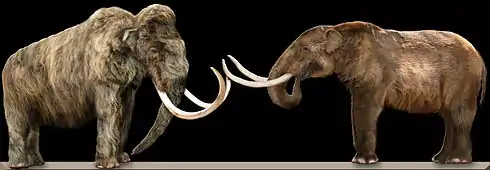List of mammals of North America
This is a list of North American mammals. It includes all mammals currently found in the United States, Canada, Greenland, Bermuda, Mexico, Central America, and the Caribbean region, whether resident or as migrants. This article does not include species found only in captivity. Mammal species which became extinct in the last 10,000 to 13,000 years are also included in this article. Each species is listed, with its binomial name. Most established introduced species occurring across multiple states and provinces are also noted.
Some species are identified as indicated below:
- (A) = Accidental: occurrence based on one or a few records, and unlikely to occur regularly
- (E) = Extinct: died out between 13,000 years ago and the present
- (Ex) = Extirpated: no longer occurs in area of interest, but other populations exist elsewhere
- (I) = Introduced: population established solely as result of direct or indirect human intervention; synonymous with non-native and non-indigenous
|
|
Conservation status - IUCN Red List of Threatened Species:
- EX - extinct, EW - extinct in the wild
- CR - critically endangered, EN - endangered, VU - vulnerable
- NT - near threatened, LC - least concern
- DD - data deficient, NE - not evaluated
- (v. 2013.2, the data is current as of March 5, 2014[1])
- E - endangered, T - threatened
- XN, XE - experimental non essential or essential population
- E(S/A), T(S/A) - endangered or threatened due to similarity of appearance
- (selected only taxa found in the US, the data is current as of March 28, 2014[2])
Opossums
Didelphidae
- Common opossum, Didelphis marsupialis LC
- Virginia opossum, Didelphis virginiana [n 1][n 2] LC
- Derby's woolly opossum, Caluromys derbianus LC
- Bare-tailed woolly opossum, Caluromys philander LC
- Water opossum, Chironectes minimus LC
- Alston's mouse opossum, Marmosa alstoni LC
- Isthmian mouse opossum, Marmosa isthmica
- Mexican mouse opossum, Marmosa mexicana LC
- Linnaeus's mouse opossum, Marmosa murina LC
- Robinson's mouse opossum, Marmosa robinsoni LC
- Dusky slender opossum, Marmosops fuscatus DD
- Panama slender opossum, Marmosops invictus LC
- Brown four-eyed opossum, Metachirus nudicaudatus LC
- Sepia short-tailed opossum, Monodelphis adusta LC
- Gray four-eyed opossum, Philander opossum LC
- Grayish mouse opossum, Tlacuatzin canescens LC
Armadillos
Dasypodidae
- Beautiful armadillo, Dasypus bellus (E)
- Nine-banded armadillo, Dasypus novemcinctus [n 3] LC
Cabassous
- Northern naked-tailed armadillo, Cabassous centralis DD
Chlamyphoridae
- American glyptodont, Glyptotherium floridanum (E)
Pampatheriidae
- American giant armadillo, Holmesina septentrionalis (E)
Anteaters and tamanduas
Cyclopedidae
- Silky anteater, Cyclopes didactylus LC
Myrmecophaga
- Giant anteater, Myrmecophaga tridactyla VU
Tamanduas
- Northern tamandua, Tamandua mexicana LC
- Southern tamandua, Tamandua tetradactyla LC
Sloths
Bradypus
- Pygmy three-toed sloth, Bradypus pygmaeus CR
- Brown-throated sloth, Bradypus variegatus LC
Choloepus
- Hoffmann's two-toed sloth, Choloepus hoffmanni LC
Megatheriidae
- American giant ground sloth, Eremotherium laurillardi (E)
Mylodontidae
- Harlan's ground sloth, Paramylodon harlani (E)
Nothrotheriidae
- Shasta ground sloth, Nothrotheriops shastensis [9] (E)
Rodents
Echimyidae
- Haitian edible rat, Brotomys contractus EX (E)
- Oriente cave rat, Boromys offella EX (E)
- Torre's cave rat, Boromys torrei EX (E)
- Hispaniolan edible rat, Brotomys voratus EX (E)
- Rufous soft-furred spiny-rat, Diplomys labilis LC
- Antillean cave rat, Heteropsomys antillensis (E)
- Insular cave rat, Heteropsomys insulans (E) EX
- Armored rat, Hoplomys gymnurus LC
- Brazilian spiny tree-rat, Makalata didelphoides LC
- Tome's spiny-rat, Proechimys semispinosus LC
- Trinidad spiny rat, Proechimys trinitatis LC
Beavers

- North American beaver, Castor canadensis [n 3] LC
- Giant beaver, Castoroides ohioensis [9] (E)
Jumping mice
- Woodland jumping mouse, Napaeozapus insignis [n 3] LC
- Meadow jumping mouse, Zapus hudsonius [n 3] LC
- (Preble's meadow jumping mouse, Z. h. preblei: T)
- Western jumping mouse, Zapus princeps [n 3] LC
- Pacific jumping mouse, Zapus trinotatus [n 3] LC
Porcupines
- Mexican hairy dwarf porcupine, Coendou mexicanus LC
- Brazilian porcupine, Coendou prehensilis LC
- Andean porcupine, Coendou quichua DD
- Rothschild's porcupine, Coendou rothschildi LC
- North American porcupine, Erethizon dorsatum [n 3] LC
Capybaras
- Lesser capybara, Hydrochoerus isthmius DD
- Pinckney's capybara, Neochoerus pinckneyi (E)
- Holmes's capybara, Neochoerus aesopi (E)
Heptaxodontidae
- Blunt-toothed giant hutia, Amblyrhiza inundata (E)
- Osborn's key mouse, Clidomys osborni (E)
- Plate-toothed giant hutia, Elasmodontomys obliquus (E)
- Twisted-toothed mouse, Quemisia gravis (E)
Dasyproctidae
- Coiban agouti, Dasyprocta coibae VU
- Red-rumped agouti, Dasyprocta leporina LC
- Mexican agouti, Dasyprocta mexicana CR
- Central American agouti, Dasyprocta punctata LC
- Ruatan Island agouti, Dasyprocta ruatanica EN
Cuniculidae
- Lowland paca, Cuniculus paca LC
Capromyidae
- Desmarest's hutia, Capromys pilorides LC
- Jamaican coney, Geocapromys brownii EN
- Cuban coney, Geocapromys columbianus (E) EX
- Bahamian hutia, Geocapromys ingrahami VU
- Little Swan Island hutia, Geocapromys thoracatus (E)
- Imposter hutia, Hexolobodon phenax (E) EX
- Montane hutia, Isolobodon montanus (E) EX
- Puerto Rican hutia, Isolobodon portoricensis (E) EX
- Hispaniolan hutia, Plagiodontia aedium EN
- Wide-toothed hutia, Plagiodontia araeum (E)
- Samana hutia, Plagiodontia ipnaeum (E)
- Cabrera's hutia, Mesocapromys angelcabrerai CR
- Eared hutia, Mesocapromys auritus EN
- Dwarf hutia, Mesocapromys nanus CR
- San Felipe hutia, Mesocapromys sanfelipensis CR
- Garrido's hutia, Mysateles garridoi CR
- Gundlach's hutia, Mysateles gundlachi VU
- Black-tailed hutia, Mysateles melanurus VU
- Isla De La Juventud tree hutia, Mysateles meridionalis CR
- Prehensile-tailed hutia, Mysateles prehensilis NT
- Lemke's hutia, Rhizoplagiodontia lemkei (E)
Geomyidae
There has been much debate among taxonomists about which races of pocket gopher should be recognized as full species, and the following list cannot be regarded as definitive.
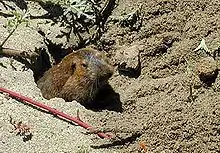
- Yellow-faced pocket gopher, Cratogeomys castanops [n 3] LC
- Oriental Basin pocket gopher, Cratogeomys fulvescens LC
- Smoky pocket gopher, Cratogeomys fumosus LC
- Goldman's pocket gopher, Cratogeomys goldmani LC
- Merriam's pocket gopher, Cratogeomys merriami LC
- Perote pocket gopher, Cratogeomys perotensis LC
- Desert pocket gopher, Geomys arenarius [n 1][n 4] NT
- Attwater's pocket gopher, Geomys attwateri [n 1] LC
- Baird's pocket gopher, Geomys breviceps [n 1] LC
- Plains pocket gopher, Geomys bursarius [n 3][n 5] LC
- Knox Jones's pocket gopher, Geomys knoxjonesi [n 1] LC
- Texas pocket gopher, Geomys personatus [n 6] LC
- Southeastern pocket gopher, Geomys pinetis [n 3] LC
- Llano pocket gopher, Geomys texensis [n 1] LC
- Chiriqui pocket gopher, Orthogeomys cavator LC
- Cherrie's pocket gopher, Orthogeomys cherriei NT
- Oaxacan pocket gopher, Orthogeomys cuniculus DD
- Darien pocket gopher, Orthogeomys dariensis LC
- Giant pocket gopher, Orthogeomys grandis LC
- Variable pocket gopher, Orthogeomys heterodus NT
- Hispid pocket gopher, Orthogeomys hispidus LC
- Big pocket gopher, Orthogeomys lanius CR
- Underwood's pocket gopher, Orthogeomys underwoodi LC
- Botta's pocket gopher, Thomomys bottae [n 7] LC
- Camas pocket gopher, Thomomys bulbivorus [n 3] LC
- Wyoming pocket gopher, Thomomys clusius [n 1] LC
- Idaho pocket gopher, Thomomys idahoensis [n 1] LC
- Mazama pocket gopher, Thomomys mazama [n 3] LC
- Mountain pocket gopher, Thomomys monticola [n 3] LC
- Northern pocket gopher, Thomomys talpoides [n 3] LC
- Townsend's pocket gopher, Thomomys townsendii [n 3] LC
- Southern pocket gopher, Thomomys umbrinus [n 3] LC
- Alcorn's pocket gopher, Pappogeomys alcorni CR
- Buller's pocket gopher, Pappogeomys bulleri LC
- Michoacan pocket gopher, Zygogeomys trichopus EN
Heteromyidae
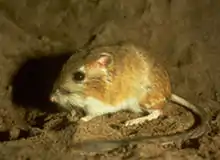
- Ord's kangaroo rat, Dipodomys ordii [n 3] LC
- Gulf Coast kangaroo rat, Dipodomys compactus [n 1] LC
- San Quintin kangaroo rat, Dipodomys gravipes CR
- Chisel-toothed kangaroo rat, Dipodomys microps [n 3] LC
- Nelson's kangaroo rat, Dipodomys nelsoni LC
- Panamint kangaroo rat, Dipodomys panamintinus [n 3] LC
- Phillips's kangaroo rat, Dipodomys phillipsii LC
- Stephens's kangaroo rat, Dipodomys stephensi [n 3] EN E
- Narrow-faced kangaroo rat, Dipodomys venustus [n 3] [n 8] LC
- Heermann's kangaroo rat, Dipodomys heermanni [n 3] LC
- (Morro Bay kangaroo rat, D. h. morroensis: E)
- California kangaroo rat, Dipodomys californicus [n 1] LC
- Giant kangaroo rat, Dipodomys ingens [n 3] EN E
- Banner-tailed kangaroo rat, Dipodomys spectabilis [n 3] NT
- Texas kangaroo rat, Dipodomys elator [n 3] VU
- Merriam's kangaroo rat, Dipodomys merriami [n 3] LC
- (San Bernardino kangaroo rat, D. m. parvus: E)
- Fresno kangaroo rat, Dipodomys nitratoides [n 3] VU
- (Fresno subspecies D. n. exilis and Tipton kangaroo rat, D. n. nitratoides: E)
- Desert kangaroo rat, Dipodomys deserti [n 3] LC
- Dulzura kangaroo rat, Dipodomys simulans [n 1] LC
- Panamanian spiny pocket mouse, Heteromys adspersus NT
- Trinidad spiny pocket mouse, Heteromys anomalus LC
- Southern spiny pocket mouse, Heteromys australis LC
- Desmarest's spiny pocket mouse, Heteromys desmarestianus LC
- Gaumer's spiny pocket mouse, Heteromys gaumeri LC
- Mexican spiny pocket mouse, Heteromys irroratus [n 3] LC
- Nelson's spiny pocket mouse, Heteromys nelsoni EN
- Painted spiny pocket mouse, Heteromys pictus LC
- Salvin's spiny pocket mouse, Heteromys salvini LC
- Jaliscan spiny pocket mouse, Heteromys spectabilis EN
- Dark kangaroo mouse, Microdipodops megacephalus [n 3] LC
- Pale kangaroo mouse, Microdipodops pallidus [n 3] LC
- White-eared pocket mouse, Perognathus alticola [n 3] EN
- Arizona pocket mouse, Perognathus amplus [n 3] LC
- Olive-backed pocket mouse, Perognathus fasciatus [n 3] LC
- Plains pocket mouse, Perognathus flavescens [n 7] LC
- Silky pocket mouse, Perognathus flavus [n 3] LC
- San Joaquin pocket mouse, Perognathus inornatus [n 3] LC
- Little pocket mouse, Perognathus longimembris [n 3] LC
- (Pacific pocket mouse, P. l. pacificus: E)
- Merriam's pocket mouse, Perognathus merriami [n 3] LC
- Columbia Plateau pocket mouse, Perognathus parvus [n 7] LC
- Little desert pocket mouse, Chaetodipus arenarius LC
- Narrow-skulled pocket mouse, Chaetodipus artus LC
- Bailey's pocket mouse, Chaetodipus baileyi [n 3] LC
- California pocket mouse, Chaetodipus californicus [n 3] LC
- Nelson's pocket mouse, Chaetodipus nelsoni [n 3] LC
- Dalquest's pocket mouse, Chaetodipus dalquesti VU
- Chihuahuan pocket mouse, Chaetodipus eremicus [n 1] LC
- San Diego pocket mouse, Chaetodipus fallax [n 3] LC
- Long-tailed pocket mouse, Chaetodipus formosus [n 3] LC
- Goldman's pocket mouse, Chaetodipus goldmani NT
- Hispid pocket mouse, Chaetodipus hispidus [n 3] LC
- Rock pocket mouse, Chaetodipus intermedius [n 3] LC
- Lined pocket mouse, Chaetodipus lineatus DD
- Desert pocket mouse, Chaetodipus penicillatus [n 3] LC
- Sinaloan pocket mouse, Chaetodipus pernix LC
- Baja pocket mouse, Chaetodipus rudinoris [n 9] LC
- Spiny pocket mouse, Chaetodipus spinatus [n 3] LC
Squirrels
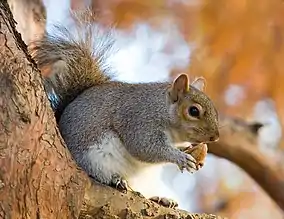
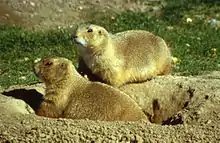

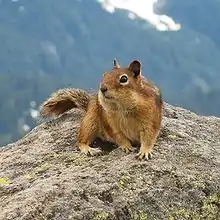
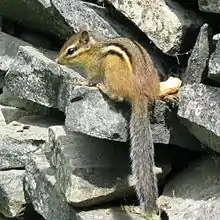
- Harris's antelope squirrel, Ammospermophilus harrisii [n 3] LC
- Espíritu Santo antelope squirrel, Ammospermophilus insularis
- Texas antelope squirrel, Ammospermophilus interpres [n 1][n 4] LC
- White-tailed antelope squirrel, Ammospermophilus leucurus [n 3][n 10] LC
- San Joaquin antelope squirrel, Ammospermophilus nelsoni [n 3] EN
- Central American dwarf squirrel, Microsciurus alfari LC
- Western dwarf squirrel, Microsciurus mimulus LC
- Abert's squirrel, Sciurus aberti [n 3] LC
- Allen's squirrel, Sciurus alleni LC
- Arizona gray squirrel, Sciurus arizonensis [n 3] DD
- Mexican gray squirrel, Sciurus aureogaster [n 11] LC
- Eastern gray squirrel, Sciurus carolinensis [n 3] LC
- Collie's squirrel, Sciurus colliaei LC
- Deppe's squirrel, Sciurus deppei LC
- Red-tailed squirrel, Sciurus granatensis LC
- Fox squirrel, Sciurus niger [n 3] LC
- (Delmarva fox squirrel, S. n. cinereus: E)
- Mexican fox squirrel, Sciurus nayaritensis [n 12] LC
- Western gray squirrel, Sciurus griseus [n 3] LC
- Peters's squirrel, Sciurus oculatus LC
- Variegated squirrel, Sciurus variegatoides LC
- Yucatan squirrel, Sciurus yucatanensis LC
- Bangs's mountain squirrel, Syntheosciurus brochus NT
- North American red squirrel, Tamiasciurus hudsonicus [n 3] LC
- (Mount Graham red squirrel, T. h. grahamensis: E)
- Douglas squirrel, Tamiasciurus douglasii [n 3] LC
- Mearns's squirrel, Tamiasciurus mearnsi EN
- Northern flying squirrel, Glaucomys sabrinus [n 3] LC
- (Carolina northern flying squirrel G. s. coloratus and Virginia northern flying squirrel G. s. fuscus: E)
- Southern flying squirrel, Glaucomys volans [n 3] LC
- Humboldt's flying squirrel, Glaucomys oregonensis
- Gunnison's prairie dog, Cynomys gunnisoni [n 3][n 5] LC
- White-tailed prairie dog, Cynomys leucurus [n 1][n 4] LC
- Black-tailed prairie dog, Cynomys ludovicianus [n 3] LC
- Utah prairie dog, Cynomys parvidens [n 1][n 4] EN T
- Mexican prairie dog, Cynomys mexicanus EN
- Alaska marmot, Marmota broweri [n 1] LC
- Hoary marmot, Marmota caligata [n 3] LC
- Yellow-bellied marmot, Marmota flaviventris [n 3] LC
- Woodchuck, Marmota monax [n 3] LC
- Olympic marmot, Marmota olympus [n 3] LC
- Vancouver Island marmot, Marmota vancouverensis [n 3] CR E
- Tropical ground squirrel, Notocitellus adocetus LC
- Ring-tailed ground squirrel, Notocitellus annulatus LC
- Baja California rock squirrel, Otospermophilus atricapillus EN
- California ground squirrel, Otospermophilus beecheyi [n 3] LC
- Rock squirrel, Otospermophilus variegatus [n 3] LC
- Golden-mantled ground squirrel, Callospermophilus lateralis [n 3][n 5] LC
- Sierra Madre ground squirrel, Callospermophilus madrensis NT
- Cascade golden-mantled ground squirrel, Callospermophilus saturatus [n 1][n 4] LC
- Mohave ground squirrel, Xerospermophilus mohavensis [n 3] VU
- Perote ground squirrel, Xerospermophilus perotensis EN
- Spotted ground squirrel, Xerospermophilus spilosoma [n 3] LC
- Round-tailed ground squirrel, Xerospermophilus tereticaudus [n 3] LC
- Franklin's ground squirrel, Poliocitellus franklinii [n 3] LC
- Rio Grande ground squirrel, Ictidomys parvidens [10] - split from Mexican ground squirrel, Ictidomys mexicanus [n 3] LC
- Thirteen-lined ground squirrel, Ictidomys tridecemlineatus [n 3] LC
- Uinta ground squirrel, Urocitellus armatus [n 3] LC
- Belding's ground squirrel, Urocitellus beldingi [n 3] LC
- Northern Idaho ground squirrel, Urocitellus brunneus [n 3] CR
- Southern Idaho ground squirrel, Urocitellus endemicus [n 3] VU
- Columbian ground squirrel, Urocitellus columbianus [n 3] LC
- Wyoming ground squirrel, Urocitellus elegans [n 1] LC
- Arctic ground squirrel, Urocitellus parryii [n 3] LC
- Richardson's ground squirrel, Urocitellus richardsonii [n 3] LC
- Townsend's ground squirrel, Urocitellus townsendii [n 3] VU
- Merriam's ground squirrel, Urocitellus canus [n 1] LC
- Piute ground squirrel, Urocitellus mollis [n 1][11] LC
- Townsend's ground squirrel, Urocitellus townsendii VU
- Washington ground squirrel, Urocitellus washingtoni [n 3] NT
- Alpine chipmunk, Neotamias alpinus [n 3] LC
- Yellow pine chipmunk, Neotamias amoenus [n 3] LC
- Buller's chipmunk, Neotamias bulleri VU
- Gray-footed chipmunk, Neotamias canipes [n 1] LC
- Gray-collared chipmunk, Neotamias cinereicollis [n 3] LC
- Cliff chipmunk, Neotamias dorsalis [n 3] LC
- Durango chipmunk, Neotamias durangae LC
- Merriam's chipmunk, Neotamias merriami [n 3] LC
- Least chipmunk, Neotamias minimus [n 3] LC
- California chipmunk, Neotamias obscurus [n 1] LC
- Yellow-cheeked chipmunk, Neotamias ochrogenys [n 1] LC
- Palmer's chipmunk, Neotamias palmeri [n 3] EN
- Panamint chipmunk, Neotamias panamintinus [n 3] LC
- Long-eared chipmunk, Neotamias quadrimaculatus [n 3] LC
- Colorado chipmunk, Neotamias quadrivittatus [n 3] LC
- Red-tailed chipmunk, Neotamias ruficaudus [n 3] LC
- Hopi chipmunk, Neotamias rufus [n 1] LC
- Allen's chipmunk, Neotamias senex [n 1] LC
- Siskiyou chipmunk, Neotamias siskiyou [n 1] LC
- Sonoma chipmunk, Neotamias sonomae [n 3] LC
- Lodgepole chipmunk, Neotamias speciosus [n 3] LC
- Eastern chipmunk, Tamias striatus [n 3] LC
- Townsend's chipmunk, Neotamias townsendii [n 3] LC
- Uinta chipmunk, Neotamias umbrinus [n 3] LC
Cricetidae
There has been much debate among taxonomists about which races of mice and voles should be recognized as full species, and the following list cannot be regarded as definitive.

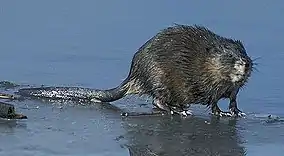
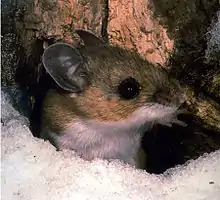
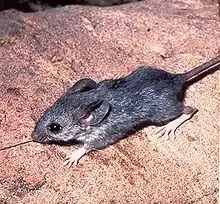
- Insular vole, Microtus abbreviatus [n 3] LC
- Beach vole, Microtus breweri [n 13][n 4] VU
- California vole, Microtus californicus [n 3] LC
- (ssp. scirpen: E)
- Gray-tailed vole, Microtus canicaudus [n 1] LC
- Rock vole, Microtus chrotorrhinus [n 3] LC
- Long-tailed vole, Microtus longicaudus [n 7] LC
- Mexican vole, Microtus mexicanus [n 14] LC
(including M. mogollonensis: LC, ssp. hualpaiensis: E) and:- Mogollon vole, Microtus mogollonensis [n 14]
- Singing vole, Microtus miurus [n 3] LC
- Montane vole, Microtus montanus [n 3] LC
- Prairie vole, Microtus ochrogaster [n 3] LC
- Tundra vole, Microtus oeconomus [n 3] LC
- Creeping vole, Microtus oregoni [n 3] LC
- Eastern meadow vole, Microtus pennsylvanicus [n 3][n 5] LC
- Woodland vole, Microtus pinetorum [n 3] LC
- Water vole, Microtus richardsoni [n 3] LC
- Townsend's vole, Microtus townsendii [n 3] LC
- Taiga vole, Microtus xanthognathus [n 3] LC
- Sagebrush vole, Lemmiscus curtatus [n 3] LC
- Muskrat, Ondatra zibethicus [n 3] LC
- White-footed vole, Arborimus albipes [n 3] LC
- Red tree vole, Arborimus longicaudus [n 3] NT
- California red tree mouse, Arborimus pomo [n 1] NT
- Western heather vole, Phenacomys intermedius [n 3] LC
- Eastern heather vole, Phenacomys ungava [n 1] LC
- Western red-backed vole, Myodes californicus [n 3] LC
- Southern red-backed vole, Myodes gapperi [n 7] LC
- Northern red-backed vole, Myodes rutilus [n 3] LC
- Northern bog lemming, Synaptomys borealis [n 3] LC
- Southern bog lemming, Synaptomys cooperi [n 3] LC
- Brown lemming, Lemmus trimucronatus [n 3] LC
- Round-tailed muskrat, Neofiber alleni [n 3] LC
- Northern collared lemming, Dicrostonyx groenlandicus [n 15] LC
- Ungava collared lemming, Dicrostonyx hudsonius [n 3] LC
- Richardson's collared lemming, Dicrostonyx richardsoni [n 1] LC
- Nelson's collared lemming, Dicrostonyx nelsoni [n 16] LC
- Ogilvie Mountains collared lemming, Dicrostonyx nunatakensis [n 17] LC
- Unalaska collared lemming, Dicrostonyx unalascensis [n 17] DD
- Anthony's woodrat, Neotoma anthonyi (E)
- White-throated woodrat, Neotoma albigula [n 3] LC
- Bunker's woodrat, Neotoma bunkeri (E)
- Bushy-tailed woodrat, Neotoma cinerea [n 3] LC
- Arizona woodrat, Neotoma devia [n 1] LC
- Eastern woodrat, Neotoma floridana [n 3] LC
- (Key Largo woodrat, N. f. smalli: E)
- Dusky-footed woodrat, Neotoma fuscipes [n 3] LC
- (ssp. riparia: E)
- Desert woodrat, Neotoma lepida [n 3] LC
- Bryant's woodrat, Neotoma bryanti [15] LC
- Allegheny woodrat, Neotoma magister [n 1] NT
- San Martín Island woodrat, Neotoma martinensis (E)
- Mexican woodrat, Neotoma mexicana [n 3] LC
- Southern Plains woodrat, Neotoma micropus [n 3] LC
- Stephen's woodrat, Neotoma stephensi [n 3] LC
- White-toothed woodrat, Neotoma leucodon [n 9] LC
- Big-eared woodrat, Neotoma macrotis [n 9] LC
- Southern pygmy mouse, Baiomys musculus LC
- Northern pygmy mouse, Baiomys taylori [n 3] LC
- Azara's broad-headed rice rat, Hylaeamys megacephalus LC
- Tweedy's crab-eating rat, Ichthyomys tweedii LC
- Yellow isthmus rat, Isthmomys flavidus LC
- Mount Pirri isthmus rat, Isthmomys pirrensis NT
- Martinique giant rice rat, Megalomys desmarestii (E) EX
- Saint Lucia giant rice rat, Megalomys luciae (E) EX
- Painted bristly mouse, Neacomys pictus DD
- Sumichrast's vesper rat, Nyctomys sumichrasti LC
- Northern grass mouse, Necromys urich LC
- Trinidad water rat, Nectomys palmipes LC
- Golden mouse, Ochrotomys nuttalli [n 3] LC
- Savanna arboreal rice rat, Oecomys speciosus LC
- Trinidad arboreal rice rat, Oecomys trinitatis LC
- St. Vincent pygmy rice rat Oligoryzomys victus (E) EX
- Peromyscus anayapahensis [16] (E)
- California mouse, Peromyscus californicus [n 3] LC
- Cactus mouse, Peromyscus eremicus [n 3] LC
- Northern Baja deer mouse, Peromyscus fraterculus [n 9] LC
- Mesquite mouse, Peromyscus merriami [n 3] LC
- Canyon mouse, Peromyscus crinitus [n 3] LC
- Eastern deermouse, Peromyscus maniculatus [n 3] LC
- Oldfield mouse, Peromyscus polionotus [n 3] LC
- (Choctawhatchee beach mouse, P. p. allophrys, Perdido Key beach mouse, P. p. trissyllepsis, St. Andrews beach mouse, P. p. peninsularis, Alabama beach mouse, P. p. ammobates and Anastasia Island beach mouse, P. p. phasma: E, Southeastern beach mouse, P. p. niveiventris: T)
- White-footed mouse, Peromyscus leucopus [n 3] LC
- Nimble-footed mouse, Peromyscus levipes LC
- Cotton mouse, Peromyscus gossypinus [n 3] LC
- (ssp. allapaticola: E)
- Aztec mouse, Peromyscus aztecus LC
- Brush mouse, Peromyscus boylii [n 3] LC
- Texas mouse, Peromyscus attwateri [n 1] LC
- Big deer mouse, Peromyscus grandis NT
- Guatemalan deer mouse, Peromyscus guatemalensis LC
- Osgood's mouse, Peromyscus gratus [n 1] LC
- Naked-eared deer mouse, Peromyscus gymnotis LC
- Northwestern deer mouse, Peromyscus keeni [n 3] LC
- Black-eared mouse, Peromyscus melanotis [n 17] LC
- Northern rock mouse, Peromyscus nasutus [n 1][n 18] LC
- Giant island deer mouse, Peromyscus nesodytes [16] (E)
- Pinyon mouse, Peromyscus truei [n 3] LC
- White-ankled mouse, Peromyscus pectoralis [n 3] LC
- Fulvous harvest mouse, Reithrodontomys fulvescens [n 3] LC
- Eastern harvest mouse, Reithrodontomys humulis [n 3] LC
- Western harvest mouse, Reithrodontomys megalotis [n 3] LC
- Plains harvest mouse, Reithrodontomys montanus [n 3] LC
- Coues's climbing mouse, Rhipidomys couesi LC
- Venezuelan climbing mouse, Rhipidomys venezuelae LC
- Salt marsh harvest mouse, Reithrodontomys raviventris [n 3] EN E
- Mearn's grasshopper mouse, Onychomys arenicola [n 1] LC
- Northern grasshopper mouse, Onychomys leucogaster [n 3] LC
- Southern grasshopper mouse, Onychomys torridus [n 3] LC
- Florida mouse, Podomys floridanus [n 3] VU
- Hispid cotton rat, Sigmodon hispidus [n 3] LC
- Yellow-nosed cotton rat, Sigmodon ochrognathus [n 3] LC
- Arizona cotton rat, Sigmodon arizonae [n 1] LC
- Bolivar rice rat, Transandinomys bolivaris LC
- Talamancan rice rat, Transandinomys talamancae LC
- Tawny-bellied cotton rat, Sigmodon fulviventer [n 3] LC
- Alston's brown mouse, Scotinomys teguina LC
- Chiriqui brown mouse, Scotinomys xerampelinus LC
- Jamaican rice rat, Oryzomys antillarum (E)
- Coues's rice rat, Oryzomys couesi [n 1] LC
- Common marsh rice rat, Oryzomys palustris [n 3][n 19] LC (ssp. natator: E)
- Nelson's rice rat, Oryzomys nelsoni (E) EX
- Nevis rice rat, Pennatomys nivalis (E) EX
- Chiapan climbing rat, Tylomys bullaris CR
- Fulvous-bellied climbing rat, Tylomys fulviventer DD
- Peters's climbing rat, Tylomys nudicaudus LC
- Panamanian climbing rat, Tylomys panamensis DD
- Tumbala climbing rat, Tylomys tumbalensis CR
- Watson's climbing rat, Tylomys watsoni LC
- Short-tailed cane rat, Zygodontomys brevicauda LC
Primates
Aotus
- Panamanian night monkey, Aotus zonalis DD
- Hispaniola monkey, Antillothrix bernensis (E)
- Haitian monkey, Insulacebus toussaintiana (E)
- Paralouatta marianae (E)
- Paralouatta varonai (E)
- Jamaican monkey, Xenothrix mcgregori (E) EX
Howler monkeys
- Coiba Island howler, Alouatta coibensis VU
- Guyanan red howler, Alouatta macconnelli LC
- Mantled howler, Alouatta palliata LC
- Guatemalan black howler, Alouatta pigra EN
Spider monkeys
- Black-headed spider monkey, Ateles fusciceps CR
- Geoffroy's spider monkey, Ateles geoffroyi EN
Cebus
- Colombian white-faced capuchin, Cebus capucinus LC
- Panamanian white-faced capuchin, Cebus imitator
Saguinus
- Geoffroy's tamarin, Saguinus geoffroyi LC
Saimiri
- Central American squirrel monkey, Saimiri oerstedii VU
Rabbits and hares
Leporidae
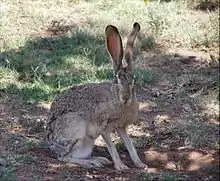
- Atzlan rabbit, Aztlanolagus agilis (E)
- Pygmy rabbit, Brachylagus idahoensis [n 3] LC E
- Antelope jackrabbit, Lepus alleni [n 3][n 5] LC
- Snowshoe hare, Lepus americanus [n 3] LC
- Arctic hare, Lepus arcticus [n 3] LC
- Black-tailed jackrabbit, Lepus californicus [n 3] LC
- White-sided jackrabbit, Lepus callotis [n 1][n 4] NT
- Tehuantepec jackrabbit, Lepus flavigularis EN
- Black jackrabbit, Lepus insularis VU
- Alaskan hare, Lepus othus [n 3] LC
- White-tailed jackrabbit, Lepus townsendii [n 3] LC
- Volcano rabbit, Romerolagus diazi EN
- Swamp rabbit, Sylvilagus aquaticus [n 3] LC
- Desert cottontail, Sylvilagus audubonii [n 3] LC
- Brush rabbit, Sylvilagus bachmani [n 3] LC (ssp. riparius: E)
- Tapeti, Sylvilagus brasiliensis EN
- Mexican cottontail, Sylvilagus cunicularius LC
- Manzano Mountain cottontail, Sylvilagus cognatus [n 20] DD
- Dice's cottontail, Sylvilagus dicei DD
- Eastern cottontail, Sylvilagus floridanus [n 3] LC
- Tres Marias cottontail, Sylvilagus graysoni EN
- Omilteme cottontail, Sylvilagus insonus DD
- San José brush rabbit, Sylvilagus mansuetus CR
- Marsh rabbit, Sylvilagus palustris [n 3] LC
- (Lower Keys marsh rabbit, S. p. hefneri: E)
- Mountain cottontail, Sylvilagus nuttallii [n 3] LC
- Appalachian cottontail, Sylvilagus obscurus [n 1] NT
- New England cottontail, Sylvilagus transitionalis [n 3] VU
- Robust cottontail, Sylvilagus robustus [n 21] EN
Ochotonidae
- Collared pika, Ochotona collaris [n 3] LC
- American pika, Ochotona princeps [n 3] LC
- Giant pika, Ochotona whartoni [16] (E)
Moles and shrews
Talpidae

- Star-nosed mole, Condylura cristata [n 3] LC
- Hairy-tailed mole, Parascalops breweri [n 3] LC
- Eastern mole, Scalopus aquaticus [n 3] LC
- Broad-footed mole, Scapanus latimanus [n 3] LC
- Coast mole, Scapanus orarius [n 3] LC
- Townsend's mole, Scapanus townsendii [n 3] LC
- American shrew-mole, Neurotrichus gibbsii [n 3] LC
Soricidae

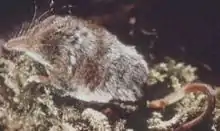
- Northern short-tailed shrew, Blarina brevicauda [n 3] LC
- Southern short-tailed shrew, Blarina carolinensis [n 1] LC and:
- Sherman's short-tailed shrew, Blarina shermani [10]
- Everglades short-tailed shrew, Blarina peninsulae [6]
- Elliot's short-tailed shrew, Blarina hylophaga [n 1] LC
- Central Mexican broad-clawed shrew, Cryptotis alticola DD
- Goldman's broad-clawed shrew, Cryptotis goldmani LC
- Goodwin's broad-clawed shrew, Cryptotis goodwini LC
- Guatemalan broad-clawed shrew, Cryptotis griseoventris EN
- Big Mexican small-eared shrew, Cryptotis magna VU
- Yucatan small-eared shrew, Cryptotis mayensis LC
- Merriam's small-eared shrew, Cryptotis merriami LC
- Mexican small-eared shrew, Cryptotis mexicana LC
- Nelson's small-eared shrew, Cryptotis nelsoni CR
- Grizzled Mexican small-eared shrew, Cryptotis obscura LC
- North American least shrew, Cryptotis parva [n 3] LC and:
- Berlandier's least shrew, Cryptotis berlandieri [10]
- Cockrum's gray shrew, Notiosorex cockrumi [n 9] LC
- Crawford's gray shrew, Notiosorex crawfordi [n 3] LC and:
- Ticul's gray shrew, Notiosorex tataticuli [10]
- Long-tailed shrew, Sorex dispar [n 22] LC
- Gaspé shrew, Sorex gaspensis[n 23]
- Smoky shrew, Sorex fumeus [n 3] LC
- American pygmy shrew, Sorex hoyi [n 3] LC and:
- Western pygmy shrew, Sorex eximius [10]
- Dwarf shrew, Sorex nanus [n 3] LC
- Ornate shrew, Sorex ornatus [n 7] LC (ssp. relictus: E)
- Inyo shrew, Sorex tenellus [n 3] LC
- Baird's shrew, Sorex bairdi [n 1] LC
- Marsh shrew, Sorex bendirii [n 3] LC
- New Mexico shrew, Sorex neomexicanus [n 9] DD
- Pacific shrew, Sorex pacificus [n 3] LC
- American water shrew, Sorex palustris [n 3][n 5] LC and:
- Fog shrew, Sorex sonomae [n 1] LC
- Vagrant shrew, Sorex vagrans [n 7] LC
- Cinereus shrew, Sorex cinereus [n 3] LC and:
- Olympic shrew, Sorex rohweri [n 24] LC (formerly in Sorex cinereus)
- Prairie shrew, Sorex haydeni [n 1] LC
- Saint Lawrence Island shrew, Sorex jacksoni [n 21][n 4] LC
- Southeastern shrew, Sorex longirostris [n 3] LC
- Mount Lyell shrew, Sorex lyelli [n 3] LC
- Preble's shrew, Sorex preblei [n 3] LC
- Pribilof Island shrew, Sorex pribilofensis [n 7] EN
- Barren ground shrew, Sorex ugyunak [n 1] LC
- Alaska tiny shrew, Sorex yukonicus [n 17] LC
- Arctic shrew, Sorex arcticus [n 3][n 5] LC
- Maritime shrew, Sorex maritimensis [n 9] LC
- Tundra shrew, Sorex tundrensis [n 1] LC
- Arizona shrew, Sorex arizonae [n 1] LC
- Merriam's shrew, Sorex merriami [n 3] LC
- Trowbridge's shrew, Sorex trowbridgii [n 3] LC
- Southern montane shrew, Sorex monticolus [n 3] LC and:
- Northern montane shrew, Sorex obscurus [10]
- Glacier Bay water shrew, Sorex alaskanus [n 25] [n 4] DD
Solenodon
- Cuban solenodon, Solenodon cubanus EN
- Marcano's solenodon, Solenodon marcanoi (E) EX
- Hispaniolan solenodon, Solenodon paradoxus EN
Nesophontes
- Puerto Rican nesophontes, Nesophontes edithae (E) EX
- Nesophontes hemicingulus (E)
- Atalaye nesophontes, Nesophontes hypomicrus (E) EX
- Slender Cuban nesophontes, Nesophontes longirostris (E)
- Greater Cuban nesophontes, Nesophontes major (E) EX
- Western Cuban nesophontes, Nesophontes micrus (E) EX
- St. Michel nesophontes, Nesophontes paramicrus (E) EX
- Lesser Cuban nesophontes, Nesophontes submicrus (E)
- Cuban nesophontes, Nesophontes superstes (E)
- Haitian nesophontes, Nesophontes zamicrus (E) EX
Bats
Vespertilionidae

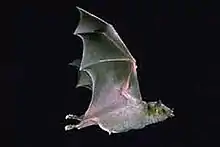
- Western pipistrelle, Pipistrellus hesperus [n 3] LC
- Eastern pipistrelle, Pipistrellus subflavus [n 3] LC
- Brazilian brown bat, Eptesicus brasiliensis LC
- Argentine brown bat, Eptesicus furinalis LC
- Big brown bat, Eptesicus fuscus [n 3] LC
- Evening bat, Nycticeius humeralis [n 3] LC
- Eastern red bat, Lasiurus borealis [n 26] LC
- Hoary bat, Lasiurus cinereus [n 3] LC
- (Hawaiian hoary bat, L. c. semotus: E)
- Southern yellow bat, Lasiurus ega [n 26] LC
- Desert red bat, Lasiurus blossevillii [10] [n 13] LC
- Seminole bat, Lasiurus seminolus [n 3] LC
- Northern yellow bat, Lasiurus intermedius [n 3] LC
- Western yellow bat, Lasiurus xanthinus [n 1] LC
- Allen's big-eared bat, Idionycteris phyllotis [n 3] LC
- Spotted bat, Euderma maculatum [n 3] LC
- Rafinesque's big-eared bat, Corynorhinus rafinesquii [n 3] LC
- Townsend's big-eared bat, Corynorhinus townsendii [n 3] LC
- (ssp. C. t. virginianus and C. t. ingens: E)
- Silver-tipped myotis, Myotis albescens LC
- Southwestern myotis, Myotis auriculus [n 1][n 27] LC
- Southeastern myotis, Myotis austroriparius [n 3] LC
- California myotis, Myotis californicus [n 3] LC
- Western small-footed myotis, Myotis ciliolabrum [n 1] LC
- Dark-nosed small-footed myotis, Myotis melanorhinus [n 28] LC
- Guatemalan myotis, Myotis cobanensis DD
- Long-eared myotis, Myotis evotis [n 3][n 5] LC
- Elegant myotis, Myotis elegans LC
- Cinnamon myotis, Myotis fortidens LC
- Gray bat, Myotis grisescens [n 3] NT E
- Keen's myotis, Myotis keenii [n 3] LC
- Eastern small-footed myotis, Myotis leibii [n 3] LC
- Little brown bat, Myotis lucifugus [n 3] LC
- Northern long-eared myotis, Myotis septentrionalis [n 1] LC
- Indiana bat, Myotis sodalis [n 3] EN E
- Fringed myotis, Myotis thysanodes [n 3] LC
- Cave myotis, Myotis velifer [n 3] LC
- Long-legged myotis, Myotis volans [n 3] LC
- Yuma myotis, Myotis yumanensis [n 3] LC
- Silver-haired bat, Lasionycteris noctivagans [n 3] LC
- Arizona myotis, Myotis occultus [n 29] LC
Molossidae
- Wagner's mastiff bat, Eumops glaucinus [n 3] LC
- Florida bonneted bat, Eumops floridanus [7] CR E
- Western mastiff bat, Eumops perotis [n 3] LC
- Underwood's mastiff bat, Eumops underwoodi [n 3] LC
- Pallas's mastiff bat, Molossus molossus [n 30] LC
- Pocketed free-tailed bat, Nyctinomops femorosaccus [n 3] LC
- Peale's free-tailed bat, Nyctinomops aurispinosus LC
- Broad-eared bat, Nyctinomops laticaudatus LC
- Big free-tailed bat, Nyctinomops macrotis [n 3] LC
- Mexican free-tailed bat, Tadarida brasiliensis [n 3] LC
Antrozoidae
- Pallid bat, Antrozous pallidus [n 3] LC
Pteronotus
- Davy's naked-backed bat, Pteronotus davyi LC
- Big naked-backed bat, Pteronotus gymnonotus LC
- Parnell's mustached bat, Pteronotus parnellii LC
- Wagner's mustached bat, Pteronotus personatus LC
Lonchophylla
- Goldman's nectar bat, Lonchophylla concava NT
- Godman's nectar bat, Lonchophylla mordax LC
- Orange nectar bat, Lonchophylla robusta LC
- Thomas's nectar bat, Lonchophylla thomasi LC
Noctilionidae
- Lesser bulldog bat, Noctilio albiventris LC
- Greater bulldog bat, Noctilio leporinus LC
Balantiopteryx
- Thomas's sac-winged bat, Balantiopteryx io VU
- Gray sac-winged bat, Balantiopteryx plicata LC
Mormoopidae
- Antillean ghost-faced bat, Mormoops blainvillii NT
- Ghost-faced bat, Mormoops megalophylla [n 3] LC
- Pristine mustached bat, Pteronotus pristinus (E) [n 31]
Phyllostomidae
- Tree bat, Ardops nichollsi LC
- Mexican long-tongued bat, Choeronycteris mexicana [n 3] NT
- Aztec fruit-eating bat, Dermanura azteca LC
- Pygmy fruit-eating bat, Dermanura phaeotis LC
- Toltec fruit-eating bat, Dermanura tolteca LC
- Thomas's fruit-eating bat, Dermanura watsoni LC
- White-winged vampire bat, Diaemus youngi LC
- Hairy-legged vampire bat, Diphylla ecaudata [n 3] LC
- Velvety fruit-eating bat, Enchisthenes hartii [n 20] LC
- Mexican long-nosed bat, Leptonycteris nivalis [n 3][n 10] EN E
- Lesser long-nosed bat, Leptonycteris yerbabuenae [n 32] VU
- California leaf-nosed bat, Macrotus californicus [n 3][n 5] LC
Desmodus
- Stock's vampire bat, Desmodus stocki (E)
- Common vampire bat, Desmodus rotundus LC
Sturnira
- Little yellow-shouldered bat, Sturnira lilium LC
- Highland yellow-shouldered bat, Sturnira ludovici LC
- Louis's yellow-shouldered bat, Sturnira luisi LC
- Talamancan yellow-shouldered bat, Sturnira mordax NT
Artibeus
- Honduran fruit-eating bat, Artibeus inopinatus DD
- Jamaican fruit bat, Artibeus jamaicensis LC
- Great fruit-eating bat, Artibeus lituratus LC
Glossophaga
- Commissaris's long-tongued bat, Glossophaga commissarisi LC
- Gray long-tongued bat, Glossophaga leachii LC
- Western long-tongued bat, Glossophaga morenoi LC
- Pallas's long-tongued bat, Glossophaga soricina LC
Carollia
- Silky short-tailed bat, Carollia brevicauda LC
- Chestnut short-tailed bat, Carollia castanea LC
- Seba's short-tailed bat, Carollia perspicillata LC
- Sowell's short-tailed bat, Carollia sowelli LC
- Gray short-tailed bat, Carollia subrufa LC
Rhynchonycteris
- Proboscis bat, Rhynchonycteris naso LC
Diclidurus
- Northern ghost bat, Diclidurus albus LC
Diaemus
- White-winged vampire bat, Diaemus youngi LC
Diphylla
- Hairy-legged vampire bat, Diphylla ecaudata LC
Natalus
- Mexican greater funnel-eared bat, Natalus mexicanus LC
Thyroptera
- Peters's disk-winged bat, Thyroptera discifera LC
- Spix's disk-winged bat, Thyroptera tricolor LC
Uroderma
- Tent-making bat, Uroderma bilobatum LC
- Brown tent-making bat, Uroderma magnirostrum LC
Vampyressa
- Striped yellow-eared bat, Vampyressa nymphaea LC
Vampyrodes
- Great stripe-faced bat, Vampyrodes caraccioli LC
Micronycteris
- Common big-eared bat, Micronycteris microtis LC
- White-bellied big-eared bat, Micronycteris minuta LC
- Schmidts's big-eared bat, Micronycteris schmidtorum LC
Anoura
- Handley's tailless bat, Anoura cultrata NT
- Geoffroy's tailless bat, Anoura geoffroyi LC
Cynomops
- Greenhall's dog-faced bat, Cynomops greenhalli LC
- Mexican dog-faced bat, Cynomops mexicanus LC
- Southern dog-faced bat, Cynomops planirostris LC
Cormura
- Chestnut sac-winged bat, Cormura brevirostris LC
Cyttarops
- Short-eared bat, Cyttarops Alecto LC
Glyphonycteris
- Davies's big-eared bat, Glyphonycteris daviesi LC
- Tricolored big-eared bat, Glyphonycteris sylvestris LC
Lonchorhina
- Tomes's sword-nosed bat, Lonchorhina aurita LC
Lophostoma
- Pygmy round-eared bat, Lophostoma brasiliense LC
- Davis's round-eared bat, Lophostoma evotis LC
- White-throated round-eared bat, Lophostoma silvicolum LC
Chrotopterus
- Big-eared woolly bat, Chrotopterus auritus LC
Lampronycteris
- Yellow-throated big-eared bat, Lampronycteris brachyotis LC
Macrophyllum
- Long-legged bat, Macrophyllum macrophyllum LC
Mimon
- Cozumelan golden bat, Mimon cozumelae LC
- Striped hairy-nosed bat, Mimon crenulatum LC
Phyllostomus
- Pale spear-nosed bat, Phyllostomus discolor LC
- Greater spear-nosed bat, Phyllostomus hastatus LC
Tonatia
- Stripe-headed round-eared bat, Tonatia saurophila LC
Trachops
- Fringe-lipped bat, Trachops cirrhosus LC
Trinycteris
- Niceforo's big-eared bat, Trinycteris nicefori LC
Promops
- Big crested mastiff bat, Promops centralis LC
Centronycteris
- Thomas's shaggy bat, Centronycteris centralis LC
Choeroniscus
- Godman's long-tailed bat, Choeroniscus godmani LC
Lichonycteris
- Dark long-tongued bat, Lichonycteris obscura LC
Centurio
- Wrinkle-faced bat, Centurio senex LC
Hylonycteris
- Underwood's long-tongued bat, Hylonycteris underwoodi LC
Musonycteris
- Banana bat, Musonycteris harrisoni VU
Mesophylla
- MacConnell's bat, Mesophylla macconnelli LC
Chiroderma
- Salvin's big-eyed bat, Chiroderma salvini LC
- Little big-eyed bat, Chiroderma trinitatum LC
- Hairy big-eyed bat, Chiroderma villosum LC
Bauerus
- Van Gelder's bat, Bauerus dubiaquercus NT
Plecotus
- Mexican big-eared bat, Plecotus mexicanus NT
Rhogeessa
- Yucatan yellow bat, Rhogeessa aeneus LC
- Genoways's yellow bat, Rhogeessa genowaysi EN
- Slender yellow bat, Rhogeessa gracilis LC
- Thomas's yellow bat, Rhogeessa io LC
- Little yellow bat, Rhogeessa parvula LC
- Black-winged little yellow bat, Rhogeessa tumida LC
Peropteryx
- Greater dog-like bat, Peropteryx kappleri LC
- Lesser doglike bat, Peropteryx macrotis LC
Phylloderma
- Pale-faced bat, Phylloderma stenops LC
Ametrida
- Little white-shouldered bat, Ametrida centurio LC
Ectophylla
- Honduran white bat, Ectophylla alba NT
Platyrrhinus
- Choco broad-nosed bat Platyrrhinus chocoensis VU
- Thomas's broad-nosed bat, Platyrrhinus dorsalis LC
- Brown-bellied broad-nosed bat, Platyrrhinus fusciventris LC
- Heller's broad-nosed bat, Platyrrhinus helleri LC
- Greater broad-nosed bat, Platyrrhinus vittatus LC
Furipterus
- Thumbless bat, Furipterus horrens LC
Natalus
- Mexican greater funnel-eared bat, Natalus mexicanus LC
- Trinidadian funnel-eared bat, Natalus tumidirostris LC
Monophyllus
- Leach's single leaf bat, Monophyllus redmani LC
Saccopteryx
- Greater sac-winged bat, Saccopteryx bilineata LC
- Lesser sac-winged bat, Saccopteryx leptura LC
Phyllonycteris
- Jamaican flower bat, Phyllonycteris aphylla CR
- Puerto Rican flower bat, Phyllonycteris major (E)
- Cuban flower bat, Phyllonycteris poeyi LC
Carnivores
Felidae
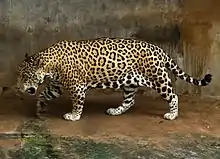
- Jaguarundi, Herpailurus yagouaroundi [n 3] LC
- (Gulf Coast jaguarundi, H. y. cacomitli and Sinaloan jauguarundi H. y. tolteca: E)
- Homotherium, Homotherium serum (E)
- Ocelot, Leopardus pardalis [n 3] LC E
- Oncilla, Leopardus tigrinus VU
- Margay, Leopardus wiedii [n 33] NT
- Canada lynx, Lynx canadensis [n 3] LC T
- Bobcat, Lynx rufus [n 3] LC
- Miracinonyx inexpectatus (E)
- Miracinonyx trumani (E)
- Panthera atrox (E)
- Jaguar, Panthera onca [n 3] NT E)
- Panthera spelaea (E)
- Cougar, Puma concolor [n 3] LC T(S/A)
- ssp. P. c. couguar and P. c. coryi: E)
- Smilodon fatalis (E)
Canines
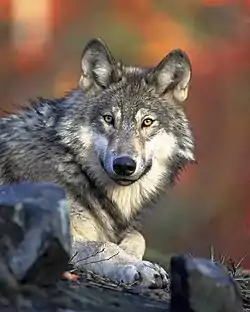
- Dire wolf, Aenocyon dirus [9] (E)
- Armbruster's wolf, Canis armbrusteri (E)
- Coyote, Canis latrans [n 3] LC
- Gray wolf, Canis lupus [n 3] LC E (and XN)
- Dhole, Cuon alpinus (Ex) EN E
- Bush dog, Speothos venaticus NT
- Gray fox, Urocyon cinereoargenteus [n 3][n 5] LC
- Island fox, Urocyon littoralis [n 1][n 4] NT
- (ssp. U.l. littoralis, U. l. catalinae, U. l. santarosae and U. l. santacruzae: E)
Bears
- Short-faced bear, Arctodus simus [9] (E)
- Florida cave bear, Tremarctos floridanus (E)
- Brown bear, Ursus arctos [n 35] LC (includes grizzly bear, U. a. horribilis: T, XN and
Alaskan brown bear or Kodiak bear, U. a. middendorffi) - American black bear, Ursus americanus [n 3] LC T(S/A)
(Louisiana black bear U. a. luteolus: T) - Polar bear, Ursus maritimus [n 3] VU T
Procyonidae
- Northern olingo, Bassaricyon gabbii LC
- Western lowland olingo, Bassaricyon medius LC
- Ringtail, Bassariscus astutus [n 3] LC
- Cacomistle, Bassariscus sumichrasti LC
- White-nosed coati, Nasua narica [n 3] LC
- Kinkajou, Potos flavus LC
- Crab-eating raccoon, Procyon cancrivorus LC
- Raccoon, Procyon lotor [n 3] LC
- Cozumel raccoon, Procyon pygmaeus CR
Mustelids
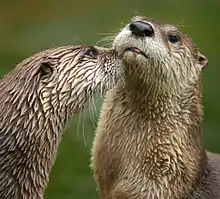
- (ssp. E. l . nereis and E. l . kenyoni: T, ssp. E. l . nereis also XN)
- Greater grison, Galictis vittata LC
- Wolverine, Gulo gulo [n 3][n 36] LC
- North American river otter, Lontra canadensis [n 3] LC
- Neotropical otter, Lontra longicaudis NT
- American marten, Martes americana [n 3] LC
- Ermine, Mustela erminea [n 3] LC
- Long-tailed weasel, Mustela frenata [n 3] LC
- Least weasel, Mustela nivalis [n 3][n 37] LC
- Black-footed ferret, Mustela nigripes [n 3] EN E (and XN)
- Sea mink, Neovison macrodon [n 20][16] (E)
- American mink, Neovison vison [n 3] LC
- Fisher, Pekania pennanti [n 3] LC
- American badger, Taxidea taxus [n 3] LC
Mephitidae
- Short-faced skunk, Brachyprotoma obtusata (E)
- American hog-nosed skunk, Conepatus leuconotus [n 38] LC
- Striped hog-nosed skunk, Conepatus semistriatus LC
- Striped skunk, Mephitis mephitis [n 3] LC
- Hooded skunk, Mephitis macroura [n 3] LC
- Southern spotted skunk, Spilogale angustifrons LC
- Western spotted skunk, Spilogale gracilis [n 1] LC
- Eastern spotted skunk, Spilogale putorius [n 3][n 19] VU
- Pygmy spotted skunk, Spilogale pygmaea VU
Eared seals
- Guadalupe fur seal, Arctocephalus townsendi [n 3][n 39] NT T
- Northern fur seal, Callorhinus ursinus [n 3] VU
- Steller sea lion, Eumetopias jubatus [n 3] NT
- (ssp. E. j. monteriensis: LC, ssp. E. j. jubatus: EN) T (except west of 144° W, where E)
- California sea lion, Zalophus californianus [n 3] LC
Earless seals
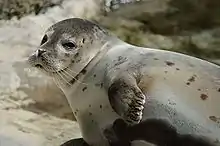
- Hooded seal, Cystophora cristata [n 3] VU
- Bearded seal, Erignathus barbatus [n 3] LC
- Ribbon seal, Histriophoca fasciata [n 3] DD
- Grey seal, Halichoerus grypus [n 3] LC
- Northern elephant seal, Mirounga angustirostris [n 3] LC
- Caribbean monk seal, Neomonachus tropicalis [n 40] (E)
- Harbor seal, Phoca vitulina [n 3] LC
- Spotted seal, Phoca largha [n 1] DD T
- Ringed seal, Pusa hispida [n 3] LC
- Harp seal, Pagophilus groenlandicus [n 3] LC
Perissodactyla
Horses
- Equus alaskae (E)
- Mexican horse, Equus conversidens [9] (E)
- Equus fraternus (E)
- Giant horse, Equus giganteus (E)
- Yukon wild horse, Equus lambei (E)
- Niobrara horse, Equus niobrarensis (E)
- Western horse, Equus occidentalis (E)
- Equus semiplicatus (E)
- Scott's horse, Equus scotti (E)
- Hagerman horse, Equus simplicidens (E)
- Stilt-legged horse, Haringtonhippus francisci (E)
Tapirs
- Baird's tapir, Tapirus bairdii EN
- Cope's tapir, Tapirus copei (E)
- California tapir, Tapirus californicus (E)
- Merriam's tapir, Tapirus merriami (E)
- Florida tapir, Tapirus veroensis (E)
Artiodactyla
Camelidae
- Camelops hesternus [9] (E)
- Camelops kansanus (E)
- Camelops minidokae (E)
- Stilt-legged llama, Hemiauchenia macrocephala (E)
- Stout-legged llama, Palaeolama mirifica (E)
Tayassuidae
- Long-nosed peccary, Mylohyus nasutus [9] (E)
- Collared peccary, Pecari tajacu [n 3] LC
- Flat-headed peccary, Platygonus compressus [9] (E)
- White-lipped peccary, Tayassu pecari LC
Bovines

- Ancient bison, Bison antiquus (E)
- American bison, Bison bison [n 3] NT (Wood bison, B. b. athabascae: T)
- Giant bison, Bison latifrons (E)
- Bison occidentalis [22] (E)
- Steppe wisent, Bison priscus (E)
- Harlan's muskox, Bootherium bombifrons [9] (E)
- Shrub-ox, Euceratherium collinum [9] (E)
- Muskox, Ovibos moschatus [n 3] LC reintroduced
- Mountain goat, Oreamnos americanus [n 3] LC
- Harrington's mountain goat, Oreamnos harringtoni [9] (E)
- Bighorn sheep, Ovis canadensis [n 3] LC
- (Desert bighorn sheep, O. c. nelsoni and Sierra Nevada bighorn sheep, O. c. sierrae: E)
- Dall sheep, Ovis dalli [n 3] LC
- (ssp. S. t. tatarica: CR, ssp. S. t. mongolica EN)
- Giant muskox, Praeovibos priscus (E)
- Saiga antelope, Saiga tatarica (Ex) CR
- Soergel's ox, Soergelia mayfieldi (E)
Cervidae
- Moose, Alces alces [n 41] LC
- Stag-moose, Cervalces scotti [9] (E)
- Elk (wapiti), Cervus canadensis [n 42] LC
- Eastern elk, C. c. canadensis EX
- Red brocket, Mazama americana DD
- Amazonian brown brocket, Mazama nemorivaga LC
- Yucatan brown brocket, Mazama pandora VU
- Central American red brocket, Mazama temama DD
- Mule deer, Odocoileus hemionus [n 3] LC
- American mountain deer, Odocoileus lucasi (E)
- White-tailed deer, Odocoileus virginianus [n 3] LC
- (Columbian white-tailed deer, O. v. leucurus and Key deer, O. v. clavium: E)
- (Migratory woodland caribou, R. t. caribou: E)
Antilocapridae
- (Sonoran pronghorn, A. a. sonoriensis: E)
- Dwarf pronghorn, Capromeryx minor (E)
- Barbour's pronghorn, Hayoceros barbouri (E)
- Shuler's pronghorn, Tetrameryx shuleri (E)
- Conkling's pronghorn, Stockoceros conklingi (E)
Delphinidae (oceanic dolphins)

- Rough-toothed dolphin, Steno bredanensis [n 26] LC
- Striped dolphin, Stenella coeruleoalba [n 26] LC
- Atlantic spotted dolphin, Stenella frontalis [n 13] DD
- Spinner dolphin, Stenella longirostris [n 26] DD
- Clymene dolphin, Stenella clymene [n 13] DD
- Pantropical spotted dolphin, Stenella attenuata [n 26] LC
- Short-beaked common dolphin, Delphinus delphis [n 26] LC
- Long-beaked common dolphin, Delphinus capensis [n 13] DD
- Common bottlenose dolphin, Tursiops truncatus [n 26] LC
- Pacific bottlenose dolphin, Tursiops (truncatus) gillii [8]
- Fraser's dolphin, Lagenodelphis hosei [n 11] LC
- Northern right whale dolphin, Lissodelphis borealis [n 26] LC
- White-beaked dolphin, Lagenorhynchus albirostris [n 26] LC
- Atlantic white-sided dolphin, Lagenorhynchus acutus [n 26] LC
- Pacific white-sided dolphin, Lagenorhynchus obliquidens [n 26] LC
- False killer whale, Pseudorca crassidens [n 26] DD
- Vaquita, Phocoena sinus CR
- Guiana dolphin, Sotalia guianensis NT
- Killer whale, Orcinus orca [n 26] DD E
- Risso's dolphin, Grampus griseus [n 26] LC
- Long-finned pilot whale, Globicephala melas [n 26] DD
- Short-finned pilot whale, Globicephala macrorhynchus [n 3] DD
- Pygmy killer whale, Feresa attenuata [n 26] DD
- Melon-headed whale, Peponocephala electra [n 13] LC
Porpoise
- Harbor porpoise, Phocoena phocoena [n 26] LC
- Dall's porpoise, Phocoenoides dalli [n 26] LC
Kogiidae
- Pygmy sperm whale, Kogia breviceps [n 26] LC
- Dwarf sperm whale, Kogia sima [n 26] (Hawaiian Islands only) LC
Physeteridae
- Sperm whale, Physeter macrocephalus [n 26] VU E
Ziphiidae (beaked whales)
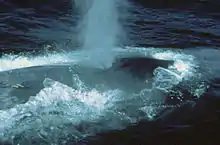
- Gervais' beaked whale, Mesoplodon europaeus [n 26] DD
- Blainville's beaked whale, Mesoplodon densirostris [n 26] DD
- True's beaked whale, Mesoplodon mirus [n 26] DD
- Sowerby's beaked whale, Mesoplodon bidens [n 26] DD
- Stejneger's beaked whale, Mesoplodon stejnegeri [n 26] DD
- Ginkgo-toothed beaked whale, Mesoplodon ginkgodens [n 26] DD
- Hubbs' beaked whale, Mesoplodon carlhubbsi [n 26] DD
- Perrin's beaked whale, Mesoplodon perrini [n 21] DD
- Hector's beaked whale, Mesoplodon hectori [n 44] (A) DD
- Pygmy beaked whale, Mesoplodon peruvianus [n 45] (A) DD
- Tropical bottlenose whale, Indopacetus pacificus [7][24] DD
- Northern bottlenose whale, Hyperoodon ampullatus [n 26] DD
- Cuvier's beaked whale, Ziphius cavirostris [n 26] LC
- Giant beaked whale, Berardius bairdii [n 26] DD (collective name for two species - Baird's beaked whale and Arnoux's beaked whale)
Eschrichtiidae
- Gray whale, Eschrichtius robustus [n 26] LC E
Balaenopteridae (rorquals)
- Blue whale, Balaenoptera musculus [n 26] EN E
- (ssp. brevicauda - pygmy blue whale: DD, ssp. musculus North Pacific stock: LR/cd, ssp. musculus North Atlantic stock: VU)
- Rice's whale, Balaenoptera ricei CR
- Fin whale, Balaenoptera physalus [n 26] EN E
- Sei whale, Balaenoptera borealis [n 26] EN E
- Common minke whale, Balaenoptera acutorostrata [n 26] LC
- Bryde's whale, Balaenoptera edeni [n 26] (A) DD
- Humpback whale, Megaptera novaeangliae [n 26] LC E
Balaenidae
- Bowhead whale, Balaena mysticetus [n 3] LC E (Bering-Chukchi-Beaufort Sea subpopulation: LR/cd, Svalbard-Barents Sea (Spitsbergen) subpopulation: CR)
- North Atlantic right whale, Eubalaena glacialis [n 26] EN E
- North Pacific right whale, Eubalaena japonica [n 28] (A) (Alaska) EN E (Northeast Pacific subpopulation: CR)
Sirenia (sea cows)
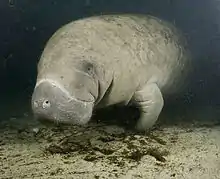
Crystal River, Florida
Trichechidae
- West Indian manatee, Trichechus manatus [n 3] VU E
- (ssp. T. m . manatus - Antillean or Caribbean manatee: EN, ssp. T. m . latirostris - Florida manatee: EN)
Dugongidae
- Steller's sea cow, Hydrodamalis gigas [7][16] (E)
Proboscidea
Elephantidae
- Columbian mammoth, Mammuthus columbi [9] (E)
- Pygmy mammoth, Mammuthus exilis [9] (E)
- Woolly mammoth, Mammuthus primigenius [16][25] (E)
Mammutidae
- American mastodon, Mammut americanum [9] (E)
Introduced mammals
Muroidea
- House mouse, Mus musculus [n 40][n 47] (I) LC
- Norway rat, Rattus norvegicus [n 48] (I) LC
- Black rat, Rattus rattus [n 48] (I) LC
Leporidae
- European hare, Lepus europaeus [n 49] (I) LC
- Cape hare, Lepus capensis [4] (I) LC
- European rabbit, Oryctolagus cuniculus [n 50] EN (I)
Herpestidae
- Small Asian mongoose, Herpestes javanicus [n 20] (I) (Caribbean) LC
Mustelidae
- Beech marten, Martes foina [7] (I) LC
See also
- List of birds of North America
- List of mammals of Mexico
- Mammals of the Caribbean
- List of mammals of Central America
- List of mammals of South America
- Great American Interchange
- List of mammal genera
- Lists of mammals by region
- List of reptiles of North America
- List of amphibians of North America
- List of U.S. state mammals
- List of U.S. state birds
- List of U.S. state reptiles
- List of U.S. state amphibians
Notes
-
Baker et al. 2003,[3] Kays & Wilson 2002,[4] North American Mammals NMNH SI,[5] Mammal Species of the World (MSW3),[6] IUCN Red List.[7] - Virginia opossum, Didelphis virginiana: Burt & Grossenheider 1976 (Peterson Field Guide)[8] - as Opossum, D. marsupialis (merged Mexican, D. marsupialis and D. virginiana).
-
Baker et al. 2003,[3] Burt & Grossenheider 1976 (Peterson Field Guide),[8] Kays & Wilson 2002,[4] North American Mammals NMNH SI,[5] Mammal Species of the World (MSW3),[6] IUCN Red List.[7] - Burt & Grossenheider 1976 (Peterson Field Guide)[8] - mentioned only in the description of another species as possible split.
- Burt & Grossenheider 1976 (Peterson Field Guide)[8] - described separately as the nominative species but merged with another species.
- Texas pocket gopher, Geomys personatus: Burt & Grossenheider 1976 (Peterson Field Guide),[8] Kays & Wilson 2002,[4] North American Mammals NMNH SI,[5] Mammal Species of the World (MSW3),[6] IUCN Red List.[7]
Baker et al. 2003,[3] - as 2 distinct species: Texas Pocket Gopher G. personatus and Strecker's Pocket Gopher G. streckeri. - Baker et al. 2003,[3] Kays & Wilson 2002,[4] North American Mammals NMNH SI,[5] Mammal Species of the World (MSW3),[6] IUCN Red List.[7]
Burt & Grossenheider 1976 (Peterson Field Guide)[8] - described as the nominative species and 1 or 2 additional distinct species. - Baker et al. 2003,[3] North American Mammals NMNH SI,[5] Mammal Species of the World (MSW3),[6] IUCN Red List.[7]
- Burt & Grossenheider 1976 (Peterson Field Guide)[8] - range not clear because described separately as the nominative species but merged with another species.
- Baker et al. 2003,[3] Kays & Wilson 2002,[4] IUCN Red List.[7]
- Mexican fox squirrel, Sciurus nayaritensis: Baker et al. 2003,[3] Kays & Wilson 2002,[4] North American Mammals NMNH SI,[5] Mammal Species of the World (MSW3),[6] IUCN Red List.[7]
Burt & Grossenheider 1976 (Peterson Field Guide)[8] - only as Apache fox squirrel S. apache. - Baker et al. 2003,[3] Kays & Wilson 2002,[4] North American Mammals NMNH SI,[5] IUCN Red List.[7]
- Mexican vole, Microtus mexicanus:
Burt & Grossenheider 1976 (Peterson Field Guide),[8] Mammal Species of the World (MSW3),[6] IUCN Red List[7] - M. mexicanus.
Baker et al. 2003,[3] Kays & Wilson 2002[4] - only M. mogollonensis.
North American Mammals NMNH SI[5] - M. mexicanus listed, but only M. mexicanus mogollensis (Arizona and New Mexico) described in "Mexican Vole (Microtus mexicanus)" chapter.
IUCN Red List[7] - M. mexicanus sometimes split in two species: M. mexicanus and M. mogollonensis.[12][13]
12 subspecies are recognized, 4 occur in the USA (1991[14]), Hualapai Mexican vole M. m. hualpaiensis is listed as endangered (E) under the Endangered Species Act.[2][14] - Northern collared lemming, Dicrostonyx groenlandicus: Kays & Wilson 2002,[4] North American Mammals NMNH SI,[5] Mammal Species of the World (MSW3),[6] IUCN Red List.[7]
Baker et al. 2003[3] - as 3 distinct species: Peary Land collared lemming D. groenlandicus, Bering collared lemming D. rubricatus and Victoria collared lemming D. kilangmiutak
Burt & Grossenheider 1976 (Peterson Field Guide),[8] - described separately as the nominative species but merged with D. exsul. - Nelson's collared lemming, Dicrostonyx nelsoni: Mammal Species of the World (MSW3),[6] IUCN Red List.[7]
Baker et al. 2003[3] - as 2 distinct species: Nelson's collared lemming D. nelsoni and St. Lawrence Island collared lemming D. exsul.
Burt & Grossenheider 1976 (Peterson Field Guide),[8] - mentioned only in the description of D. groenlandicus as possible split (D. exsul). - Baker et al. 2003,[3] Mammal Species of the World (MSW3),[6] IUCN Red List.[7]
- Northern rock mouse, Peromyscus nasutus: Burt & Grossenheider 1976 (Peterson Field Guide)[8] - mentioned only in the description of rock mouse, Peromyscus difficilis that P. difficilis was formerly known as P. nasuts, so range is not clear because these species are merged here.
- Burt & Grossenheider 1976 (Peterson Field Guide)[8] - described separately as the nominative species but probably merged with another species.
- Mammal Species of the World (MSW3),[6] IUCN Red List.[7]
- Baker et al. 2003,[3] North American Mammals NMNH SI,[5] IUCN Red List.[7]
- Long-tailed shrew, Sorex dispar: IUCN Red List.[7]
Baker et al. 2003,[3] Burt & Grossenheider 1976 (Peterson Field Guide),[8] Kays & Wilson 2002,[4] Mammal Species of the World (MSW3),[6] North American Mammals NMNH SI[5]
- as 2 distinct species: longtail/long-tailed shrew S. dispar and Gaspé shrew S. gaspensis. - Gaspé shrew, Sorex gaspensis: Baker et al. 2003,[3] Burt & Grossenheider 1976 (Peterson Field Guide),[8] Kays & Wilson 2002,[4] Mammal Species of the World (MSW3),[6] North American Mammals NMNH SI[5]
- North American Mammals NMNH SI,[5] IUCN Red List.[7]
- Baker et al. 2003,[3] IUCN Red List.[7]
- Baker et al. 2003,[3] Burt & Grossenheider 1976 (Peterson Field Guide),[8] Kays & Wilson 2002,[4] North American Mammals NMNH SI,[5] IUCN Red List.[7]
- Southwestern myotis, Myotis auriculus: Burt & Grossenheider 1976 (Peterson Field Guide)[8] - mentioned only in the description of long-eared myotis, M. evotis as possible split, occurring in southern N. Mexico.
- North American Mammals NMNH SI,[5] Mammal Species of the World (MSW3),[6] IUCN Red List.[7]
- Baker et al. 2003,[3] Burt & Grossenheider 1976 (Peterson Field Guide),[8] North American Mammals NMNH SI,[5] Mammal Species of the World (MSW3),[6] IUCN Red List.[7]
- Velvety free-tailed bat: Baker et al. 2003,[3] North American Mammals NMNH SI,[5] Mammal Species of the World (MSW3),[6] IUCN Red List.[7]
Kays & Wilson 2002[4] - it is believed that colonies found in buildings in the Florida Keys were members of Molossidae. - Prinstine mustached bat: Mammal Species of the World (MSW3)[6] - possibly Florida.
Extinct at the end of Pleistocene - in the USA found in Rancholabrean cave deposits in southern Florida (Monkey Jungle Hammock).[19] - Lesser long-nosed bat, Leptonycteris yerbabuenae: Kays & Wilson 2002,[4] North American Mammals NMNH SI,[5] Mammal Species of the World (MSW3),[6] IUCN Red List.[7]
Baker et al. 2003[3] - as southern long-nosed bat L. curasoae (L. yerbabuenae was included[20] in L. curasoae as a subspecies[21]).
Burt & Grossenheider 1976 (Peterson Field Guide)[8] - mentioned only in the description of L. nivalis under the junior synonym[20] L. sanborni as possible split, so range is not clear here. - Margay: Baker et al. 2003,[3] Burt & Grossenheider 1976 (Peterson Field Guide),[8] Mammal Species of the World (MSW3).[6]
Kays & Wilson 2002:[4] last record in Texas from 1852.[4] - Red fox, Vulpes vulpes: Burt & Grossenheider 1976 (Peterson Field Guide)[8] - as North American V. fulva distinct from the Old World species V. vulpes.
- Brown bear, Ursus arctos: Baker et al. 2003,[3] Kays & Wilson 2002,[4] North American Mammals NMNH SI,[5] Mammal Species of the World (MSW3),[6] IUCN Red List.[7]
Burt & Grossenheider 1976 (Peterson Field Guide)[8] - as 2 distinct species: grizzly bear, U. horribilis and Kodiak bear, U. middendorffi, also distinct from the "worldwide" species U. arctos. - Wolverine, Gulo gulo: Burt & Grossenheider 1976 (Peterson Field Guide)[8] - as North American G. luscus distinct from the Old World species G. gulo.
- Least weasel, Mustela nivalis: Burt & Grossenheider 1976 (Peterson Field Guide)[8] - as North American M. rixosa distinct from the Old World species M. nivalis.
- American hog-nosed skunk, Conepatus leuconotus: Baker et al. 2003,[3] Burt & Grossenheider 1976 (Peterson Field Guide),[8] North American Mammals NMNH SI,[5] Mammal Species of the World (MSW3),[6] IUCN Red List.[7]
Kays & Wilson 2002[4] - as 2 distinct species: eastern hog-nosed skunk C. leuconotus and western hog-nosed skunk C. mesoleucus. - Guadalupe fur seal, Arctocephalus townsendi: Burt & Grossenheider 1976 (Peterson Field Guide)[8] - as Guadalupe fur seal A. philippi, formerly A. townsendi.
- Baker et al. 2003,[3] Burt & Grossenheider 1976 (Peterson Field Guide),[8] Kays & Wilson 2002,[4] Mammal Species of the World (MSW3),[6] IUCN Red List.[7]
- Moose, Alces americanus: North American Mammals NMNH SI,[5] Mammal Species of the World (MSW3),[6] - as North American A. americanus (distinct from Eurasian elk A. alces).
Alces alces: IUCN Red List,[7] Burt & Grossenheider 1976 (Peterson Field Guide),[8] Kays & Wilson 2002.[4] - Elk, Cervus canadensis: Baker et al. 2003,[3] Burt & Grossenheider 1976 (Peterson Field Guide),[8] North American Mammals NMNH SI[5] (species list from the database).
Kays & Wilson 2002,[4] North American Mammals NMNH SI[5] (Field Guide), Mammal Species of the World (MSW3),[6] IUCN Red List[7] - as "worldwide" C. elaphus (not North American C. canadensis.) - Caribou, Rangifer tarandus: Baker et al. 2003,[3] Kays & Wilson 2002,[4] North American Mammals NMNH SI,[5] Mammal Species of the World (MSW3),[6] IUCN Red List.[7]
Burt & Grossenheider 1976 (Peterson Field Guide)[8] - as 3 distinct species: woodland caribou, R. caribou, barren-ground caribou, R. arcticus and Greenland caribou R. tarandus. - Kays & Wilson 2002,[4] IUCN Red List.[7]
- Pygmy beaked whale: Kays & Wilson 2002:[4] one record in North America, Division of Mammals Collections NMNH SI:[23] two strandings in California (2001 and 2012).
- Baker et al. 2003,[3] Burt & Grossenheider 1976 (Peterson Field Guide),[8] Kays & Wilson 2002,[4] IUCN Red List.[7]
- House mouse: Baker et al. 2003,[3] Burt & Grossenheider 1976 (Peterson Field Guide),[8] Kays & Wilson 2002,[4] IUCN Red List.[7]
Mammal Species of the World (MSW3)[6] - only general range description. - Baker et al. 2003,[3] Burt & Grossenheider 1976 (Peterson Field Guide),[8] Kays & Wilson 2002.[4]
- Baker et al. 2003,[3] Burt & Grossenheider 1976 (Peterson Field Guide),[8] Mammal Species of the World (MSW3),[6] IUCN Red List.[7]
- European rabbit: Baker et al. 2003.[3]
Kays & Wilson 2002[4] - range not clear (islands on Pacific Coast).
Introduced to Hawaii.[26] - Sus scrofa: Baker et al. 2003[3] - feral pig or wild boar, Burt & Grossenheider 1976 (Peterson Field Guide)[8] - wild boar (Swine), Kays & Wilson 2002[4] - wild boar, Mammal Species of the World (MSW3)[6] - wild boar - feral populations, IUCN Red List[7] - wild boar - introduced.
- Baker et al. 2003,[3] Kays & Wilson 2002,[4] Mammal Species of the World (MSW3),[6] IUCN Red List.[7]
- Barbary sheep - free ranging.[38][39]
- Blackbuck - free ranging.[38][39][40][41]
- Nilgai - semi-free-ranging[38]/free-ranging.[39]
- Bezoar ibex - free-ranging: Florida Mountains near Deming New Mexico.[40]
- Gemsbok - free ranging.[42][40]
- Mouflon: Baker et al. 2003[3] - European mouflon sheep Ovis aries, Mammal Species of the World (MSW3)[6] - red sheep Ovis aries - mouflon introduced, improved domestic stock feral.
Feral sheep - free-ranging - Hawaii[43] and Texas.[44] - Chital - free-ranging.[38]
- Red deer, elaphus division (not canadensis division) - introduced [6]
- Sambar - free ranging.[39]
- Species listed in Baker et al. 2003, but omitted in this article: European ferret, Mustela putorius, Himalayan tahr, Hemitragus jemlahicus.
References
- "The IUCN Red List of Threatened Species". International Union for Conservation of Nature and Natural Resources. Retrieved 5 March 2014.
- "Title 50: Wildlife and Fisheries, § 17.11 Endangered and threatened wildlife". US Government Printing Office. Retrieved March 28, 2014.
- Robert J. Baker; Lisa C. Bradley; Robert D. Bradley; Jerry W. Dragoo; Mark D. Engstrom; Robert S. Hoffmann; Cheri A. Jones; Fiona Reid; Dale W. Rice & Clyde Jones (1 December 2003). "Revised checklist of North American mammals north of Mexico, 2003" (PDF). Occasional Papers. Museum of Texas Tech University (229). ISSN 0149-175X. Retrieved 9 March 2014.
- Kays, Roland W.; Wilson, Don E. (2002). Mammals of North America. Illustrated by Sandra Doyle, Nancy Halliday, Ron Klingner, Elizabeth McClelland, Consie Powell, Wendy Smith, Todd Zalewski, Diane Gibbons, Susan C. Morse, Jesse Guertin. Princeton and Oxford: Princeton University Press. ISBN 0-691-07012-1.
- "North American Mammals". Smithsonian Institution. National Museum of Natural History. Retrieved 1 April 2014.
This site is based on The Smithsonian Book of North American Mammals, by Don E. Wilson and Sue Ruff (Smithsonian Institution Press, 1999) and Mammals of North America, by Roland W. Kays and Don E. Wilson (Princeton University Press, 2002).
Downloaded on 25 March 2014 -
- Wilson, D. E.; Reeder, D. M., eds. (2005). Mammal Species of the World (3rd ed.). Johns Hopkins University Press. ISBN 0-8018-8221-4.
- "Search Results: Mammalia North America 2014-03-29". IUCN Red List of Threatened Species. Version 2013.2. IUCN. 2013. Retrieved 1 April 2014.
Search terms Search by taxonomy: Mammalia, Search by location: North America, (Native, Introduced, Vagrant, Uncertain), Refinements : [X] Show regional assessments:, Taxa to show: Species, Subspecies and varieties, Stocks and subpopulation. Downloaded on 29 March 2014
- Burt, William Henry (Text and Maps); Grossenheider, Richard Philip (Illustrations) (1976). A Field Guide to the Mammals. North America north of Mexico. Peterson Field Guides (Third ed.). Boston, New York: Houghton Mifflin Company. ISBN 0-395-91098-6.
- Haynes, Gary, ed. (23 December 2008). American Megafaunal Extinctions at the End of the Pleistocene (Vertebrate Paleobiology and Paleoanthropology). Springer Science + Business Media B. V. ISBN 978-1402087929. Retrieved 2014-04-11.
-
- Mammal Diversity Database (2020). "Mammal Diversity Database. (2020). Mammal Diversity Database (Version 1.2) [Data set]. Zenodo". doi:10.5281/zenodo.4139818. Retrieved 2 December 2020. Cite journal requires
|journal=(help)
- Mammal Diversity Database (2020). "Mammal Diversity Database. (2020). Mammal Diversity Database (Version 1.2) [Data set]. Zenodo". doi:10.5281/zenodo.4139818. Retrieved 2 December 2020. Cite journal requires
- Yensen, E. 2019. Urocitellus mollis . The IUCN Red List of Threatened Species 2019: e.T116989381A116989399. Downloaded on 12 December 2019.
- Álvarez-Castañeda, S.T. & Reid, F. (2008). "Microtus mexicanus". IUCN Red List of Threatened Species. 2008. Retrieved 2 April 2014.
- Musser, G.G.; Carleton, M.D. (2005). "Microtus (see comments) mexicanus". In Wilson, D.E.; Reeder, D.M (eds.). Mammal Species of the World: A Taxonomic and Geographic Reference (3rd ed.). Johns Hopkins University Press. pp. 894–1531. ISBN 978-0-8018-8221-0. OCLC 62265494.
- U.S. Fish and Wildlife Service (1991). Hualpai Mexican Vole Recovery Plan (PDF). Albuquerque, New Mexico. pp. 28 pp. Retrieved 2014-04-02.
- Álvarez-Castañeda, S.T., Lacher, T. & Vázquez, E. (2017). "Neotoma bryanti". IUCN Red List of Threatened Species. 2017: e.T117189944A22371413. doi:10.2305/IUCN.UK.2017-3.RLTS.T117189944A22371413.en. Retrieved 16 January 2018.CS1 maint: multiple names: authors list (link)
- Turvey, Samuel T. (May 28, 2009). Holocene Extinctions. Oxford New York: Oxford University Press. ISBN 978-0199535095. Retrieved 2014-04-11.
- Whitaker, John O.; Hamilton, William John (1998-06-28). Mammals of the Eastern United States (3rd ed.). Cornell University Press. ISBN 9780801434754. Retrieved 2 April 2014.
- Hutterer, R. (2005). "Sorex (Otisorex) cinereus". In Wilson, D.E.; Reeder, D.M (eds.). Mammal Species of the World: A Taxonomic and Geographic Reference (3rd ed.). Johns Hopkins University Press. pp. 220–311. ISBN 978-0-8018-8221-0. OCLC 62265494.
- Morgan, Gary S.; Emslie, Steven D. (2010). "Tropical and western influences in vertebrate faunas from the Pliocene and Pleistocene of Florida" (PDF). Quaternary International. 217 (1–2): 143–158. Bibcode:2010QuInt.217..143M. doi:10.1016/j.quaint.2009.11.030. Retrieved 11 April 2014.
- Simmons, N.B. (2005). "Leptonycteris yerbabuenae". In Wilson, D.E.; Reeder, D.M (eds.). Mammal Species of the World: A Taxonomic and Geographic Reference (3rd ed.). Johns Hopkins University Press. pp. 312–529. ISBN 978-0-8018-8221-0. OCLC 62265494.
- Arroyo-Cabrales, J.; Miller, B.; Reid, F.; Cuarón, A.D. & de Grammont, P.C. (2008). "'Leptonycteris yerbabuenae'". IUCN Red List of Threatened Species. 2008. Retrieved 8 April 2014.
- Hall, Stephen Austin (Aug 1972). "Holocene Bison occidentalis from Iowa". Journal of Mammalogy. 53 (3): 604–606. doi:10.2307/1379052. JSTOR 1379052.
- "Search the Division of Mammals Collections".
Keywords: Mesoplodon peruvianus: STR 13453 Stranding, Skull, Salinas State Beach, Monterey Bay, California, 2001, STR 18334: Stranding, Photograph, Arcata, Humboldt County, California, 2012
- Taylor, B.L.; Baird, R.; Barlow, J.; Dawson, S.M.; Ford, J.; Mead, J.G.; Notarbartolo di Sciara, G.; Wade, P. & Pitman, R.L. (2008). "Indopacetus pacificus". IUCN Red List of Threatened Species. 2008: e.T40635A10345818. doi:10.2305/IUCN.UK.2008.RLTS.T40635A10345818.en. Retrieved 16 January 2018.
- Crossen, K. S. (2005). "5,700-Year-Old Mammoth Remains from the Pribilof Islands, Alaska: Last Outpost of North America Megafauna". Geological Society of America. 37: 463. Archived from the original on 5 September 2018. Retrieved 3 April 2014.
- Bloggs, Fred (2011). "The history of mammal eradications in Hawai`i and the United States associated islands of the Central Pacific". In Veitch, C. R; Clout, M. N; Towns, D. R (eds.). Island invasives: eradication and management. Gland, Switzerland: IUCN. pp. 67–73.
- The State | Homepage Archived 2004-08-26 at the Wayback Machine
- Development of the Morgan Island rhesus monkey col... [P R Health Sci J. 1989] - PubMed Result
- "Archived copy". Archived from the original on 2008-09-21. Retrieved 2010-01-14.CS1 maint: archived copy as title (link)
- Wolfe, Linda, Cambridge University Press (2002). Primates Face to Face. p. 320. ISBN 0-521-79109-X.CS1 maint: multiple names: authors list (link)
- The Illustrated Encyclopedia of North American Mammals: A Comprehensive Guide to Mammals of North America. Mobi Reference. Boston: MobileReference. 2008. ISBN 9781605012797. Retrieved 2 April 2014.
- "Archived copy". Archived from the original on 2011-07-26. Retrieved 2010-01-14.CS1 maint: archived copy as title (link)
- Exotics in Texas by: Max Traweek and Roy Welch. April 1992. Texas Parks and Wildlife Department. Reproduced from PWD-BK-W7000-206 5/92
- Bowers, Nora; Bowers, Rick; Kaufmann, Kenn (2004). Mammals of North America. Kaufman focus guides. New York: Houghton Mifflin Harcourt. p. 168. ISBN 0-618-15313-6. Retrieved 2014-04-04.
- Deal, Kevin (2010). Wildlife and Natural Resource Management (3rd ed.). Cengage Learning. ISBN 978-1-4354-5401-9. Retrieved 2014-04-05.
- "Blackbuck - North America Introduced". Big Game Hunting Records - Safari Club International Online Record Book. Safari Club International. 2007–2014. Retrieved 2014-04-05.
- Whitford, Walter G. (April 2002). Ecology of Desert Systems (1st ed.). Elsevier Science. ISBN 9780127472614. Retrieved 2014-04-02.
- Cox, George W. (1999). Alien Species in North America and Hawaii. Washington DC: Island Press. p. 180. ISBN 1-55963-679-3. Retrieved 2014-04-04.
- "European Mouflon - North America Introduced". Big Game Hunting Records - Safari Club International Online Record Book. Safari Club International. 2007–2014. Retrieved 2014-04-05.
- Timmins, R.; Duckworth, J.W.; Samba Kumar, N.; Anwarul Islam, M.; Sagar Baral, H.; Long, B. & Maxwell, A. (2012). "'Axis porcinus'". IUCN Red List of Threatened Species. 2012. Retrieved 4 April 2014.
- Nowak, Ronald M. (29 July 1999). Walker's Mammals of the World (6th ed.). Johns Hopkins University Press. ISBN 0-8018-5789-9.
Further reading
- Kays, Roland W.; Wilson, Don E. (2002). Mammals of North America. Illustrated by Sandra Doyle, Nancy Halliday, Ron Klingner, Elizabeth McClelland, Consie Powell, Wendy Smith, Todd Zalewski, Diane Gibbons, Susan C. Morse, Jesse Guertin. Princeton and Oxford: Princeton University Press. ISBN 0-691-07012-1.
- Burt, William Henry (Text and Maps); Grossenheider, Richard Philip (Illustrations) (1976). A Field Guide to the Mammals. North America north of Mexico. Peterson Field Guides (Third ed.). Boston, New York: Houghton Mifflin Company. ISBN 0-395-91098-6.
- Robert J. Baker; Lisa C. Bradley; Robert D. Bradley; Jerry W. Dragoo; Mark D. Engstrom; Robert S. Hoffmann; Cheri A. Jones; Fiona Reid; Dale W. Rice & Clyde Jones (1 December 2003). "Revised checklist of North American mammals north of Mexico, 2003" (PDF). Occasional Papers. Museum of Texas Tech University (229). ISSN 0149-175X. Retrieved 9 March 2014.
External links
- American Society of Mammalogists
- Databases: Division of Mammals: Department of Vertebrate Zoology: NMNH - i.e. printable Field Guide to mammals of North America
- Search the Division of Mammals Collections - National Museum of Natural History, Smithsonian Institution
- Mammal Species of the World, 3rd edition (MSW3) - database of mammalian taxonomy
- IUCN Red List of Threatened Species (Search results: mammalia, North America, 2014-03-29)
- Endangered Species Program - US Fish & Wildlife Service
- Species Search - US Fish & Wildlife Service
- Endangered Species Act - National Marine Fisheries Service - NOAA
- List of Endangered and threatened wildlife - US Government Printing Office

